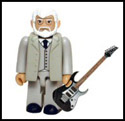|
To expand, here's how I use/maintain my planes. I have a 5,6,and 8. I used to use the 6 as a jointer, but finally bought a #8 a couple months ago. When I flatten a board I first go cross grain with the #5. My #5 has a rounded iron, and I have no idea if the soul is flat or not, it's used for rough work only. Then I go at it with the grain with the #6 or #8 (depending on the length of the board), to remove the curves left by the iron on the #5. It IS important that these planes be relatively flat. To flatten, mark the front edge, the front and back edge of the mouth and the back edge of the plane with a sharpie. Use a long piece of sandpaper across a table saw/jointer/piece of granite and start flattening. Keep one hand on the knob and one hand on the tote, and apply even pressure. It's worth noting that many people make sure the sides of the sole are in line too, but if you're also using this plane as to joint boards you'll probably develop a convex hollow down the length of the plane, this usually keeps things in line naturally. I baby my smoothing plane, and flatten it regularly, fortunately it is smaller and easier to flatten. Regularly oil/wax your planes. WD-40 is good, but I like to use canning wax from the grocery store. It's amazing how much easier it is to push a waxed bottom plane.
|
|
|
|

|
| # ? May 28, 2024 17:14 |
|
Should I be wary of over-cleaning these planes? I'm not talking about anything abrasive, but I was thinking maybe some mineral spirits and a rag/toothbrush to get any gunk out. I have a few less-well-treated planes from my father's garage (by no fault of his: it's just that he lives in a rainforest with an average ambient humidity of like 80%) that I'd also like to do a little work on, they'll need a bit more aggressive attention but I don't want to go overboard.
|
|
|
|
|
Dust can lead to rust (salts in the dust catch water in the air). Your plan sounds good, I usually just oil my planes, though.
|
|
|
|
And flattening a large plane isn't too bad, you just need a large flat surface like a tablesaw or big piece of granite (check it, they are not all flat), glue down your sandpaper and go to town. Nice score on the planes.
|
|
|
|
iwannabebobdylan posted:Nah, but that was a huge difference when I first got the saw, for sure. I've had it over a year now and am on blade 8 or 9, and I don't remember ever thinking "Man, this saw is really cutting well." It's weird. Does it have a start and a run capacitor? The run capacitor may have been bad, and finally failed completely.
|
|
|
|
One Legged Ninja posted:Does it have a start and a run capacitor? The run capacitor may have been bad, and finally failed completely. DING DING DING WE HAVE A WINNER!!! You are the man. PS testing capacitors is kinda confusing.
|
|
|
|
Bad Munki posted:Holy crap, I am all kinds of excited today. Look what just came in the mail! I have that Millers Falls brace and a set of bits. Yes Ill go to my cordless drill most of the time but sometimes Ill reach for the brace just for the hell of it. It is handy when all the batteries are dead or in an off grid situation. Youd be surprised at how well they work
|
|
|
|
Bad Munki posted:Holy crap, I am all kinds of excited today. Look what just came in the mail! Very nice, those look to be in great shape. There are a couple good books that deal with just plane tune-up, sharpening, care, etc if that appeals to you. Otherwise there are some good resources on youtube as well- Paul Sellers, Rob Cosman for example.
|
|
|
|
I'm thinking about building my own computer desk. What I'm considering right now is getting hardwood plywood for the desk surface. Is that a good idea? I don't have a workshop so plane/clamp/glueing boards together would be rather challenging to me, to say nothing of having to buy a zillion clamps to do something that large I assume. I have a hand router, though no bits for it yet. I'd like to use that to round the edges. Is that even doable with good plywood or am I going to have to glue solid wood to the edge and router that? Without a table saw or anything it makes getting wood to the right size/accuracy rather challenging I think. For the legs I might use pipes or something like that. It'll be pretty basic but I like my desks to have lots of open space so I won't be doing any drawers or anything. The other thing I am thinking of is making a raised part on the desk for a monitor stand. My first thought was be dovetailing the sides of the raised part to the monitor platform but I guess dovetails don't work too well with plywood? After some googling I saw other joint suggestions that work with plywood though again most of them want a table saw to make them. So in short: Is high quality hardwood plywood a suitable material for building a desk? What is a good joint for joining 2 pieces of plywood at 90 degrees that doesn't require a table saw?
|
|
|
|
Squibbles posted:I'm thinking about building my own computer desk. - Plywood is fine - Yes you can round the edges on a good quality ply... however, consider (a) the look of it and (b) that the glue is actually really hard on the blade edge of the bit. You can put small grooves in a jointer blade just by running plywood over it. Otherwise you're right, the solution is profiled hardwood edging. - no, dovetails would be sloppy to do with plywood unless you're using a router jig or CNC. You'll have to go with a 90deg butt joint, I think, if you don't have a tablesaw. If you have a drill you may be able to put together a reasonably useful dowelling jig which will make for a very strong joint. You could also do some sort of locking joint, like a Lock Miter Bit or, cheaper, a drawer lock bit.
|
|
|
|
Guitarchitect posted:You'll have to go with a 90deg butt joint, I think, if you don't have a tablesaw. If you have a drill you may be able to put together a reasonably useful dowelling jig which will make for a very strong joint. You could also do some sort of locking joint, like a Lock Miter Bit or, cheaper, a drawer lock bit. I was looking at some router bits like that but without a router table will it even be possible to accurately use them? Maybe some kind of jig with the router to keep it from going too deep I suppose? I also saw finger joints suggested somewhere which might be more doable than dovetails I guess. Also, thanks for the info 
|
|
|
I'm making an octopus mobile for my daughter, or maybe for a friend's new kid. Still needs some boats and fish and such hanging from the arms, but it's going pretty well so far. Secretly, it's actually a kraken and any boats hanging from the arms will be its ill-fated victims. The hardest part was figuring out the joinery needed to get all 8 arms intersecting in the middle. Proudly, I did it in my head. This goes on the bottom:  (Had a break from trying to force it when it was fitting too tightly, fortunately the grain was all intact and I was actually able to get the break to fit back into itself for an apparently perfectly strong glue joint which is hidden behind other arms.) Then this slips into that, forming an X of 4 arms:  Then this goes over the two of them at a 45°:  And lastly the head piece slips down over it all, forming two imposed Xs of arms: 
|
|
|
|
|
That's awesome! Clever on the joinery, made it look too easy. What kind of finish are you going with? e: Also the head looks like Jupiter 
|
|
|
|
I dunno, something simple, probably just something to keep it from turning totally grey. Not planning on staining it or anything.
|
|
|
|
|
Yea, it has a nice grain pattern. Since it is for kids, I'd just go with mineral oil.
|
|
|
|
I was thinking salad bowl finish, but close enough.
|
|
|
|
|
where is the dog chariot. where is it.
|
|
|
rotor posted:where is the dog chariot. where is it. Haha...she's not even walking yet, I've got time.
|
|
|
|
|
BUT I DONT
|
|
|
|
Squibbles posted:So in short: I also recommend solid edging and butt joints, dowels wouldn't be a bad idea. You can also reinforce the butt joint with wood corner cleats. Like so:  rotor posted:where is the dog chariot. where is it. Exactly, you can't mention something like that and not follow up.
|
|
|
|
re:desk construction Dados could be cut with a router, but you will need some sort of cross brace to prevent racking.
|
|
|
|
Thanks for the further advice. Gonna have to take a trip to windsor plywood and check out what kind of wood to get 
|
|
|
|
Cmdr. Chompernuts posted:re:desk construction on a monitor stand, the verticals aren't going to be all that high and it's going to be fairly stationary. He doesn't need to worry about cross-bracing and racking. now if he was doing the desk that way...
|
|
|
|
Router bit sizes don't match plywood sizes so it would involve making 2 passes. Not a big deal but dadoes aren't going to add much.
|
|
|
|
wormil posted:Router bit sizes don't match plywood sizes so it would involve making 2 passes. Not a big deal but dadoes aren't going to add much. They don't? That being said, you're right that dadoes are probably not necessary when butt joints and corner braces are way easier. Squibbles, do you have some idea how the legs are going on this desk? Or any thoughts on bracing/storage? I don't know what your design ideas are but if you're interested in making quality plywood furniture, I really recommend picking up this book by Philip Schmidt about plywood furniture design. He's got a couple good desk projects outlined and, more importantly, the beginning of the book is dedicated to showing you how to work with plywood as opposed to solid wood. (p.s. Baltic Birch, in my opinion, looks fantastic with a 1/4" roundover if you like the sort of modern look of exposed veneers)
|
|
|
|
That's what I get for relying on my tablesaw and not ever using my router. Cool looking book btw.
|
|
|
|
Magnus Praeda posted:They don't? I wasn't really planning on making any storage. My current desk doesn't have any and I'm fine with it. As for legs I was thinking of using iron pipe. Oh also I noticed Lee Valley has plywood router bits I think. I'll take a look at that book!
|
|
|
|
I was hoping somebody in here could help me id some wood. I've been looking at the wood database linked several pages ago but I've only just gotten into woodwork. I recently bought a home made sometime around 1880 and the trim in some of the rooms has been painted over about 8 times. Since we're refinishing some of the rooms anyways I wanted to strip it down and refinish the bare wood. It would be nice to know what this is though.  
|
|
|
|
Looks somewhat like what we have. My rental house has a beauitful pine door with surviving molding around it and flooring throughout (with some large patches and other issues so it is carpeted now), it looks a lot different than what you can go to Lowe's and buy these days  This is a photo from the web, our flooring isn't at all in this kind of shape. Our doors and molding though have never been painted, which is amazing in a 125+ year old house.
|
|
|
|
Chickenbisket posted:I was hoping somebody in here could help me id some wood. I've been looking at the wood database linked several pages ago but I've only just gotten into woodwork. I recently bought a home made sometime around 1880 and the trim in some of the rooms has been painted over about 8 times. Since we're refinishing some of the rooms anyways I wanted to strip it down and refinish the bare wood. It would be nice to know what this is though. I'd guess Oak. Can you take a pic of the endgrain? Are those pics right after stripping, or did you sand it at all? 100+ years and a variety of finishes can really change the visual characteristics of a wood surface.
|
|
|
|
Chickenbisket posted:I was hoping somebody in here could help me id some wood. I've been looking at the wood database linked several pages ago but I've only just gotten into woodwork. I recently bought a home made sometime around 1880 and the trim in some of the rooms has been painted over about 8 times. Since we're refinishing some of the rooms anyways I wanted to strip it down and refinish the bare wood. It would be nice to know what this is though. Where are you located? That can help narrow things down in a house that old. They used all kinds of species back then that aren't commercially sold today. Oak wouldn't be my first guess, I don't see any rays in the grain.
|
|
|
|
My first impression was fir but more clues would help... pics of the end grain, is it hard or soft, heavy or light, are there pores, what part of the country, etc. Like said above, being that old it could be anything.
|
|
|
|
Chickenbisket posted:I was hoping somebody in here could help me id some wood. I've been looking at the wood database linked several pages ago but I've only just gotten into woodwork. I recently bought a home made sometime around 1880 and the trim in some of the rooms has been painted over about 8 times. Since we're refinishing some of the rooms anyways I wanted to strip it down and refinish the bare wood. It would be nice to know what this is though. Could be Pine.
|
|
|
|
I'm really thinking pine too. Looks like the trim in my parents house.
|
|
|
|
With the streak of color in the center, it makes me think Poplar, but it's awfully straight grained for Poplar.
|
|
|
|
Looks like old dry fir to me. I wouldn't count out pine, but my money's on fir.
|
|
|
|
|
The photos are after it was sanded with some 80 grit. The house is in central Indiana. Ill try to get some photos of the end grain when I get off work tonight. Thanks for the help so far.
|
|
|
|
On my phone I was leaning toward fir, seeing the larger pics now I'm about 50/50 fir or pine. Back then they could get some really nice pine. Whatever it is, reuse it if possible or save it, don't throw it away.
|
|
|
|
I'm almost 100% certain that's Fir. That streak looks like a pitch pocket (or the remnants of one) which along with the colour pretty much seals the deal.
|
|
|
|

|
| # ? May 28, 2024 17:14 |
|
I got a couple pictures of the end grain. I'm not real certain on how to really gauge the porosity, I'm pretty new to working with wood, I've basically only ever worked with wood you can find in big box stores around here, so basically just pine. Most of the pieces are attached to the wall but I did take out the sash weight access panels and they seem to be fairly heavy for their size, they're maybe a foot by 3 inches wide by 2 inches thick and they seem like they seems fairly heavy for their size. 
|
|
|






















